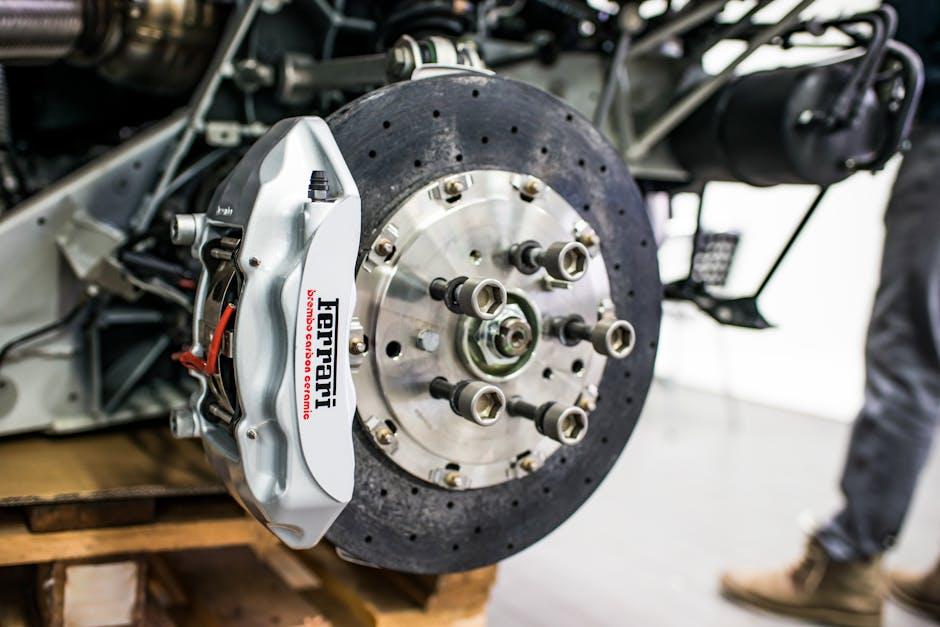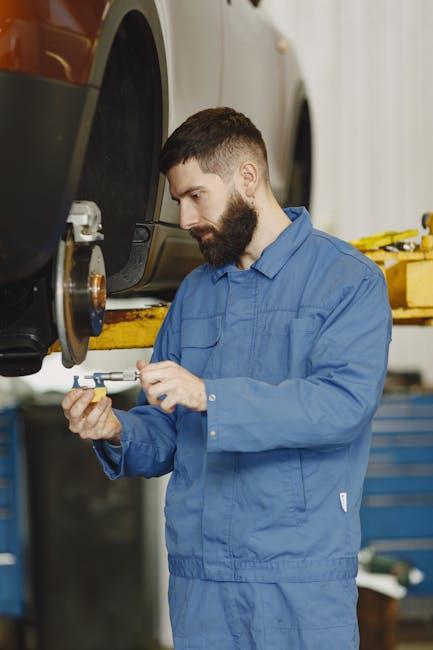Imagine pressing the brake pedal and feeling it sink closer to the floor with every effort, or worse, not responding at all when you need it most. Brakes are the unsung heroes of every journey, silently ensuring our safety mile after mile. But what happens when these critical components start to falter? Can you drive with bad brakes, or is it a risk too great to take? In this article, we’ll explore the dangers, legal considerations, and practical advice surrounding driving with compromised braking systems, helping you make informed decisions before you take the wheel.
Table of Contents
- Understanding the Risks of Driving with Faulty Brakes
- Common Signs Your Brakes Need Immediate Attention
- How Brake Malfunctions Affect Vehicle Control and Safety
- Emergency Measures to Take When Brake Failure Occurs
- Essential Brake Maintenance Tips to Prevent Dangerous Situations
- When to Seek Professional Brake Inspection and Repair
- Q&A
- To Wrap It Up

Understanding the Risks of Driving with Faulty Brakes
Driving with malfunctioning brakes introduces a spectrum of dangers that extend far beyond mere inconvenience. The inability to stop your vehicle promptly can drastically increase the risk of collisions, putting not just your life but also the lives of passengers, pedestrians, and other drivers at stake. Faulty brakes compromise control during emergency maneuvers, escalade stopping distances, and may lead to unpredictable vehicle behavior on slippery or uneven surfaces. It’s critical to recognize that braking systems operate under immense stress, and any impairment can provoke catastrophic consequences within seconds.
Among the prominent risks are:
- Longer stopping distance: Faulty brakes reduce the vehicle’s ability to slow down effectively, especially at high speeds.
- Brake failure: Complete loss of braking capability may occur, causing dangerous situations in heavy traffic or steep descents.
- Overheated brakes: Constant slipping or dragging due to defects can lead to brake fade, further reducing performance.
- Uneven wear: Damage may cause the vehicle to pull to one side when braking, leading to loss of control.
| Symptom | Potential Risk | Immediate Action |
|---|---|---|
| Squeaking or Grinding Noises | Worn Brake Pads | Replace Pads Immediately |
| Spongy Brake Pedal | Air in Brake Lines | Bleed Brake System |
| Brake Warning Light | Potential System Fault | Diagnostics & Repair |
| Pulling to One Side | Uneven Brake Wear | Brake Inspection & Alignment |

Common Signs Your Brakes Need Immediate Attention
Recognizing the warning signs your braking system is in trouble can be the difference between a safe journey and a potential disaster. One of the most noticeable indicators is a squealing or grinding noise when you apply pressure to the brake pedal. This sound often means the brake pads are worn down and need replacement. Additionally, if your vehicle pulls to one side when braking, it might signal uneven brake pad wear or a problem with the brake fluid system. Pay close attention if you experience a spongy or soft pedal, which can indicate air in the brake lines or hydraulic issues.
Another subtle but crucial sign is a longer stopping distance than usual. If your brakes don’t respond as quickly or you find yourself pressing the pedal harder to slow down, it’s time to get your system inspected. Some drivers notice vibrations or pulsations in the brake pedal or steering wheel during braking, which may point to warped rotors. Below is a quick reference of symptoms and potential causes to help you stay vigilant:
| Symptom | Possible Cause |
|---|---|
| Squealing Noise | Worn Brake Pads |
| Pulling to One Side | Uneven Pad Wear or Fluid Issue |
| Soft Brake Pedal | Air in Brake Lines |
| Longer Stopping Distance | Brake Fluid Leak or Worn Components |
| Vibrations | Warped Rotors |

How Brake Malfunctions Affect Vehicle Control and Safety
When brakes start to fail, the immediate consequence is a dramatic decrease in your ability to control the vehicle’s speed and stop on demand. This can lead to dangerously increased stopping distances, making it difficult to avoid collisions, especially in emergency situations or heavy traffic. Even slight malfunctions such as spongy brake pedals or inconsistent brake response introduce uncertainty during driving, which can severely compromise your reaction time and decision-making on the road.
Beyond just increased stopping distances, brake issues can cause uneven braking force distribution. This imbalance often leads to:
- Vehicle instability: The car may pull to one side, making steering control tricky and unpredictable.
- Increased risk of skidding: Especially on wet or icy surfaces, where traction is already reduced.
- Brake fade: Reduced brake performance after repetitive use, common on downhill slopes or long drives.
The table below summarizes how specific brake malfunctions impact vehicle behavior and safety:
| Brake Issue | Effect on Vehicle Control | Safety Risk |
|---|---|---|
| Worn Brake Pads | Longer stopping distances | Collision hazard |
| Brake Fluid Leak | Spongy brake pedal feel | Unexpected brake failure |
| Warped Brake Rotors | Vibration during braking | Reduced control on stops |

Emergency Measures to Take When Brake Failure Occurs
In the heart-stopping moment when your brakes fail, staying calm becomes your most powerful tool. Begin by pumping the brakes rapidly if your vehicle has conventional hydraulic brakes; this can sometimes rebuild enough pressure to slow your car. If that doesn’t work, gently downshift to lower gears to utilize the engine’s resistance to help reduce speed. Engage the hazard lights immediately to warn other drivers of your emergency, and search for an escape route where you can safely bring your car to a stop. Avoid slamming the steering wheel abruptly to prevent losing control.
If you find yourself on a slope or near an incline, use the roadside barriers or guardrails as friction surfaces by gently contacting them to help scrub off speed, being mindful not to lose control. Alternatively, look for open spaces such as emergency lanes, gravel roads, or grassy areas to steer into; these surfaces can assist in slowing the vehicle more effectively than paved roads. Here’s a quick checklist of emergency actions:
- Pump the brake pedal repeatedly.
- Downshift to a lower gear.
- Activate hazard lights immediately.
- Search for safe escape routes or emergency lanes.
- Use roadside barriers or soft terrain to slow down.
- Prepare for a controlled stop and avoid sudden maneuvers.
| Step | Action | Reason |
|---|---|---|
| 1 | Pump Brake Pedal | Rebuild hydraulic pressure |
| 2 | Downshift | Use engine braking |
| 3 | Activate Hazards | Alert other drivers |
| 4 | Find Escape Route | Bring vehicle safely to a stop |

Essential Brake Maintenance Tips to Prevent Dangerous Situations
Taking proactive steps to maintain your braking system is critical for ensuring safety on the road. Regularly inspect brake pads and rotors for signs of wear, such as thinning or grooves, and listen carefully for unusual squealing or grinding noises that signal potential problems. Don’t overlook the importance of brake fluid—ensuring it remains at the correct level and is replaced according to manufacturer recommendations helps prevent corrosion and maintains optimal brake responsiveness.
Incorporating simple habits into your driving routine can also extend the life of your brakes. Avoid harsh braking when possible by anticipating traffic flow, and perform routine checks on brake lines and connections during tire rotations or oil changes. Below is a quick checklist to keep handy for essential brake maintenance:
- Inspect brake pads: Replace if thickness is under 3mm.
- Check brake fluid: Top up or replace every 2 years.
- Listen for sounds: Squeaking or grinding indicates wear.
- Examine brake rotors: Look for warping or scoring.
- Assess brake lines: Watch for leaks or rust.
| Maintenance Task | Recommended Frequency |
|---|---|
| Brake Pad Inspection | Every 10,000 miles |
| Brake Fluid Replacement | Every 2 years |
| Brake System Check | Annually |

When to Seek Professional Brake Inspection and Repair
When your brakes start making unusual noises like squealing or grinding, it’s a clear sign that professional evaluation is overdue. Even subtle changes, such as a longer stopping distance or a soft brake pedal, should never be ignored. These symptoms often indicate worn pads or potential damage to the hydraulic system, both of which require expert attention to ensure your safety on the road. Additionally, if you feel vibrations or pulling to one side when braking, it could signal uneven wear or rotor issues — conditions best handled by skilled technicians.
Seek expert help immediately if you notice any of the following:
- Persistent brake warning lights on the dashboard
- Burning smell after braking
- Unusual dashboard vibrations
- Brake pedal feels spongy or sinks to the floor
- Visible brake fluid leaks underneath the vehicle
| Symptom | Suggested Action |
|---|---|
| Squealing noise | Brake pad replacement |
| Soft brake pedal | Hydraulic system inspection |
| Brake warning light | Immediate professional diagnosis |
| Car pulls during braking | Brake alignment check |
Q&A
Q: Can you drive with bad brakes?
A: Technically, yes—but it’s highly unsafe and strongly discouraged. Bad brakes compromise your ability to stop or slow down effectively, increasing the risk of accidents.
Q: What exactly counts as “bad brakes”?
A: Bad brakes can mean worn brake pads, leaking brake fluid, spongy brake pedals, or any malfunction that reduces braking power or responsiveness.
Q: How do you know if your brakes are bad?
A: Warning signs include squealing or grinding noises, a soft or sinking brake pedal, vibrations when braking, and longer stopping distances.
Q: What are the dangers of driving with bad brakes?
A: Reduced braking power means you can’t stop in time to avoid collisions, especially in emergencies. It also endangers pedestrians, other drivers, and yourself.
Q: Can you drive at low speeds if your brakes are bad?
A: While slower speeds reduce stopping distances, even at low speeds poor brakes can cause accidents. It’s safer to avoid driving until repairs are made.
Q: What should you do if you realize your brakes are failing while driving?
A: Stay calm, gradually apply the brakes, use your emergency brake if needed, and try to steer safely to the side of the road. Call for roadside assistance immediately.
Q: How often should brakes be checked?
A: Brake inspections should be part of regular vehicle maintenance—typically every 10,000 to 15,000 miles or as recommended by your vehicle’s manufacturer.
Q: Is it expensive to fix bad brakes?
A: Costs vary depending on the issue—from affordable brake pad replacements to more involved repairs like fluid flushes or brake line fixes. However, investing in brake repairs is always cheaper than risking an accident.
Q: Can bad brakes cause other car problems?
A: Yes, poor braking performance can strain other components like tires and suspension, leading to additional wear and potential damage.
Q: Bottom line—should you ever drive with bad brakes?
A: No. Driving with bad brakes is a gamble with your safety and others’. Get them inspected and repaired promptly to keep the road safe for everyone.
To Wrap It Up
In the end, driving with bad brakes is like walking a tightrope without a safety net—a risk that’s rarely worth the thrill. Your brakes are not just parts of your car; they are the guardians of every journey, whispering safety with every stop. While it might be tempting to ignore the warning signs, remember that slowing down today can mean speeding towards a safer tomorrow. When in doubt, trust the signs, listen to your vehicle, and never compromise safety for convenience. After all, the road ahead is always better traveled with brakes you can believe in.

